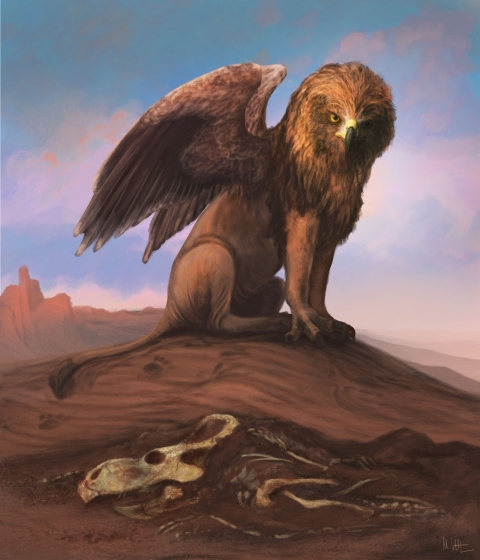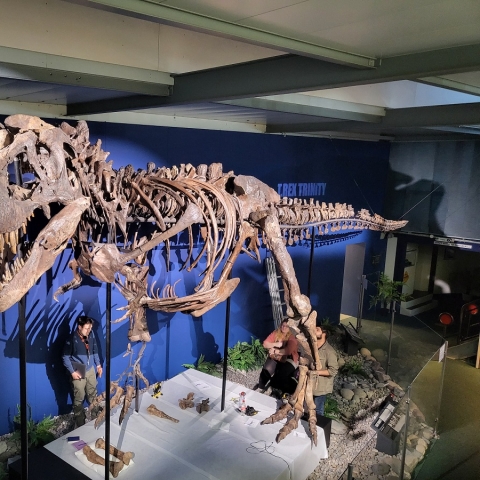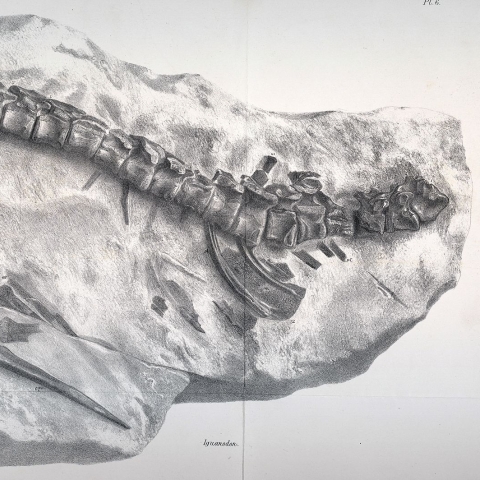

For centuries, scientists thought they knew where the griffin legend came from. A new study takes a closer look at the data and folklore’s influence on science.
21 June 2024
5 minutes
A popular and widely-promoted claim that dinosaur fossils inspired the legend of the griffin, the mythological creature with a raptorial bird head and wings on a lion body, has been challenged in a new study.
The specific link between dinosaur fossils and griffin mythology was proposed over 30 years ago in a series of papers and books written by folklorist Adrienne Mayor. These started with the 1989 Cryptozoology paper entitled ‘Paleocryptozoology: a call for collaboration between classicists and cryptozoologists’, and was cemented in the seminal 2000 book ‘The First Fossil Hunters. The idea became a staple of books, documentaries and museum exhibits.
It suggests that an early horned dinosaur of Mongolia and China, Protoceratops, was discovered by ancient nomads prospecting for gold in Central Asia. Tales of Protoceratops bones then travelled southwest on trade routes to inspire, or at least influence, stories and art of the griffin.
Griffins are some of the oldest mythological creatures, first appearing in Egyptian and Middle Eastern art during the 4th millennium BC, before becoming popular in ancient Greece during the 8th century BC.
Protoceratops was a small (around 2 metres long) dinosaur that lived in Mongolia and northern China during the Cretaceous period (75-71 million years ago). They belong to the horned dinosaur group, making it a relative of Triceratops, although they actually lack facial horns. Like griffins, Protoceratops stood on four legs, had beaks, and had frill-like extensions of their skulls that, it’s been argued, could be interpreted as wings.
Everything about griffin origins is consistent with their traditional interpretation as imaginary beasts, just as their appearance is entirely explained by them being chimaras of big cats and raptorial birds. Invoking a role for dinosaurs in griffin lore, especially species from distant lands like Protoceratops, not only introduces unnecessary complexity and inconsistencies to their origins, but also relies on interpretations and proposals that don’t withstand scrutiny.
Dr Mark Witton, Palaeontologist
In the first detailed assessment of the claims, study authors Dr Mark Witton and Richard Hing, palaeontologists at the University of Portsmouth, re-evaluated historical fossil records, the distribution and nature of Protoceratops fossils, and classical sources linking the griffin with the Protoceratops, consulting with historians and archeologists to fully understand the conventional, non-fossil based view of griffin origins. Ultimately, they found that none of the arguments withstood scrutiny.
Ideas that Protoceratops would be discovered by nomads prospecting for gold, for instance, are unlikely when Protoceratops fossils occur hundreds of kilometres away from ancient gold sites. In the century since Protoceratops was discovered, no gold has been reported alongside them. It also seems doubtful that nomads would have seen much of Protoceratops skeletons, even if they prospected for gold where their fossils occur.
“There is an assumption that dinosaur skeletons are discovered half-exposed, lying around almost like the remains of recently-deceased animals,” said Dr Witton. “But generally speaking, just a fraction of an eroding dinosaur skeleton will be visible to the naked eye, unnoticed to all except for sharp-eyed fossil hunters.
“That’s almost certainly how ancient peoples wandering around Mongolia encountered Protoceratops. If they wanted to see more, as they’d need to if they were forming myths about these animals, they’d have to extract the fossil from the surrounding rock. That is no small task, even with modern tools, glues, protective wrapping and preparatory techniques. It seems more probable that Protoceratops remains, by and large, went unnoticed — if the gold prospectors were even there to see them.”

Comparisons between the skeleton of Protoceratops and ancient griffin art. The griffins are all very obviously based on big cats, from their musculature and long, flexible tails to the manes (indicated by coiled “hair” on the neck), and birds, and differ from Protoceratops in virtually all measures of proportion and form. Image compiled from illustrations in Witton and Hing (2024); © Mark P. Witton.
Similarly, the geographic spread of griffin art through history does not align with the scenario of griffin lore beginning with Central Asian fossils and then spreading west. There are also no unambiguous references to Protoceratops fossils in ancient literature.
Protoceratops is only griffin-like in being a four-limbed animal with a beak. There are no details in griffin art suggesting that their fossils were referenced but, conversely, many griffins were clearly composed from features of living cats and birds.
Dr Witton added: “Everything about griffin origins is consistent with their traditional interpretation as imaginary beasts, just as their appearance is entirely explained by them being chimaras of big cats and raptorial birds. Invoking a role for dinosaurs in griffin lore, especially species from distant lands like Protoceratops, not only introduces unnecessary complexity and inconsistencies to their origins, but also relies on interpretations and proposals that don’t withstand scrutiny.”
It is important to distinguish between fossil folklore with a factual basis — that is, connections between fossils and myth evidenced by archaeological discoveries or compelling references in literature and artwork — and speculated connections based on intuition.
There is nothing inherently wrong with the idea that ancient peoples found dinosaur bones and incorporated them into their mythology, but we need to root such proposals in realities of history, geography and palaeontology. Otherwise, they are just speculation.
Richard Hing, Palaeontologist
The authors are keen to stress that there is excellent evidence of fossils being culturally important throughout human history, and innumerable instances of fossils inspiring folklore around the world, referred to as ‘geomyths’.
Richard Hing said: “It is important to distinguish between fossil folklore with a factual basis — that is, connections between fossils and myth evidenced by archaeological discoveries or compelling references in literature and artwork — and speculated connections based on intuition.
“There is nothing inherently wrong with the idea that ancient peoples found dinosaur bones and incorporated them into their mythology, but we need to root such proposals in realities of history, geography and palaeontology. Otherwise, they are just speculation.”
Dr Witton added: “Not all mythological creatures demand explanations through fossils. Some of the most popular geomyths — Protoceratops and griffins, fossil elephants and cyclopes, and dragons and dinosaurs — have no evidential basis and are entirely speculative. We promote these stories because they’re exciting and seem intuitively plausible, but doing so ignores our growing knowledge of fossil geomyths grounded in fact and evidence. These are just as interesting as their conjectural counterparts, and probably deserve more attention than entirely speculated geomythological scenarios.”
The study is published in Interdisciplinary Science Reviews.
Other stories you might be interested in
Gigantic Jurassic pterosaur fossil unearthed in Oxfordshire
A team of palaeontologists has discovered a fossil of a gigantic flying reptile from the Jurassic period with an estimated wingspan of more than three metres - making it one of the largest pterosaurs ever found from that era.
3 June 2024
4 min read

Portsmouth-based team lead scientific work on the multimillion-dollar T. rex skeleton ‘Trinity’
12 April 2024
3 minutes

New fossil shows Europe had different herbivorous dinosaurs to Asia and America
15 September 2023
5 minutes

